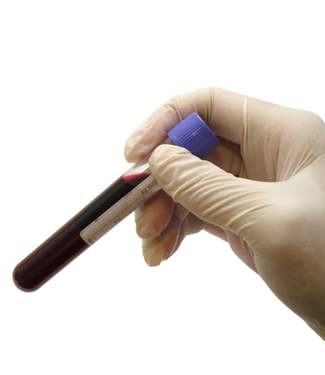Biomarker Combo Could Predict Prostate Cancer Survival
A combination of biomarkers has shown promise as a surrogate for survival in clinical trials of metastatic castration-resistant prostate cancer.
Image © Eugene Sim / Shutterstock.com

In a phase III clinical trial, a combination of biomarkers-circulating tumor cells (CTCs) and lactate dehydrogenase (LDH) level-has shown promise as a surrogate for survival in metastatic castration-resistant prostate cancer (CRPC). The combination was “shown to satisfy the four Prentice criteria for individual-level surrogacy,” according to the study. The results are published in the Journal of Clinical Oncology.
Howard I. Scher, MD, chair of urologic oncology at the Memorial Sloan Kettering Cancer Center, New York, New York, and colleagues analyzed samples from 711 men who took part in the COU-AA-301 phase III clinical trial, a study which tested the efficacy of prednisone plus abiraterone acetate compared to prednisone alone in metastatic CRPC patients who were previously treated with docetaxel.
Both CTCs and LDH level were measured prior to the first dose on trial and at 4, 8, and 12 weeks from trial initiation. This analysis was a planned secondary objective of the clinical trial.
A lower number of detectable CTCs (≤ 4 cells/7.5 mL of blood) has previously been shown to be a sign of favorable prognosis, whereas a higher number of CTCs (≥ 5/7.5 mL) is associated with an unfavorable prognosis. CTC number has also been demonstrated as prognostic and predictive of overall survival in prior clinical trials.
Risk groups were defined according to CTCs and LDH level: high risk (CTCs ≥ 5 cells/7.5mL of blood; LDH > 250 U/L); intermediate risk (CTCs ≥ 5; LDH ≤ 250), and low risk (CTCs ≤ 4; any LDH). Median overall survival was 8.71 months, 12.02 months, and 22.18 months for the high-, intermediate-, and low-risk groups, respectively. The treatment effect on the surrogate was statistically significant (P < .001), which satisfied a Prentice criteria, and the ability of the surrogate marker panel to predict mortality was high, according to the study results.
Using biomarker data from the 12-week time point, the probability of 1-year survival in high-risk patients was 25%, compared with 51% for intermediate-risk patients, and 82% for low-risk patients. The probability of 2-year survival in high-risk patients was 2%, compared with 10% for intermediate-risk patients, and 46% for low-risk patients.
CTC count or LDH level alone can predict patient prognosis, and an elevated CTC count or LDH level at 12 weeks is associated with a worse survival time, but alone neither is enough to serve as a surrogate marker for survival, a more stringent criteria. But, CTC count plus LDH level together may provide a surrogate for overall survival. “That LDH level would add to CTC count is plausible, both scientifically and biologically,” stated the authors. “Tumors that continue to shed cells into circulation are likely to be more aggressive than those that do not, and although LDH level, an indicator of tumor burden, is only elevated in a small proportion of men with progressive CRPC, the impact on survival is highly negative when it is.”
Surrogate endpoints, wrote the authors, are needed because the currently available treatments-five therapies were approved for metastatic CRPC in the last 3 years-have increased the survival of men with CRPC, making it more difficult to demonstrate an overall survival benefit for newer therapies in development. “Future trials designed with a primary endpoint of survival will have to be larger, longer running, and more costly, with a higher risk of failure,” wrote the authors.
“Urgently needed are reproducible and reliable post-treatment outcome measures that are surrogates for survival that can be used to guide patient management and facilitate regulatory approval,” wrote the authors. “Using surrogate endpoints would speed up drug development time and costs.”
Other phase III trials are also testing whether this biomarker panel demonstrates individual-level surrogacy to confirm these data.
Navigating Treatment Intensification in Metastatic Hormone-Sensitive Prostate Cancer
A patient case of a 50-year-old man with hormone-sensitive prostate cancer sparked a debate among oncologists regarding the best course of action.






